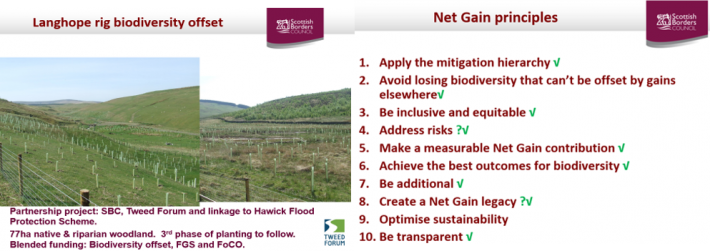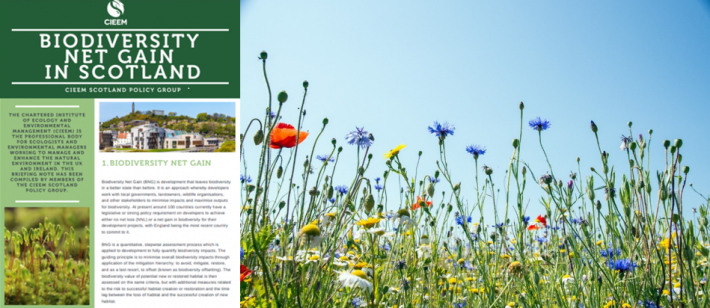Opportunities for Implementing Biodiversity Net Gain in Scotland
This ‘Pie and a Pint’ event was jointly held online by the British Ecological Society (BES) Scottish Policy Group (SPG) and Chartered Institute of Ecology and Environmental Management (CIEEM) on 8th September 2020. Annie Robinson kindly wrote a blog about her experience at the event.
Find out more below…

After the in-person event was postponed from the 1st April it was great so many people could join the online event in September. The evening started off with some speed presentations from invited speakers.
Speed Presentations
Vikki Patton, Ramboll, set the scene by defining Biodiversity Net Gain (BNG) as development that leaves biodiversity measurably better than before, and discussing how it is being implemented internationally. In Scotland, many organisations such as CalMac, Scottish & Southern Electricity Networks, Scottish Power, and Network Rail have trialled and are delivering on BNG and there is a growing body of consultants utilising BNG metrics as a tool for leaving biodiversity in a measurably better state than pre-development. In summary, it’s very deliverable. However, policy and legislation are deemed to be lagging behind to make BNG a requirement like in other countries (it will be mandated in England this year through the Environment Bill), and level the playing field across the board.
David Burslem, Aberdeen University, told us about a research project conducted by Liliana Mijares in collaboration with Aberdeenshire Council and Aberdeen City Council, to help council planning departments to become better prepared for the future introduction of BNG policies. Using two approved planning applications (a housing development near Banchory, Aberdeenshire; and the new home for Aberdeen Football Club) the study looked at how implementation of BNG would help identify potential biodiversity loss and the importance of careful site selection. It was highlighted that legislation is very much needed, and that permanency of mitigation is quite a big issue to address. Traditional survey methods do not address all the information needed and there needs to be more consideration of ecosystem services and connectivity. Take home message: “you can’t just consider on-site biodiversity; we need a landscape-scale approach”.
Francis Williams, Scottish and Southern Electricity Networks, talked about how BNG approaches have been trialled successfully for sub-station sites where the land is owned by SSEN, with the aim that SSEN will achieve total BNG from 2025, but this a precursor to wider Environmental Net Gain. Scottish specific variations were made to the DEFRA metric. Logistical challenges such as staff training, data recording and longer-term visions all require consideration and future steps include engaging third sector stakeholders and local communities. The trade-offs between wins for climate change (carbon) vs. biodiversity present challenges from some stakeholders. BNG is now considered at optioneering stage – site optioneering toolkit is used to define the site condition, and ecological mitigation required. A key issue is it needs long term input into management plans, with ongoing monitoring and adaptive management required.
Andy Tharme, Scottish Borders Council, explained that mitigation and compensation measures may include:
- retention or restoration of key habitats and features on the development site
- creation of new habitats on or off site
- appropriate management and aftercare of habitats on or off site
- provision of access for education and awareness
There are 5 key steps of the Scottish Borders biodiversity offset Net Gain mechanism and integral to it is partnership working with developers, across the council and LBAP partners. There are now 13 Delivery-Biodiversity offset schemes in the Scottish Borders this includes Langhope rig biodiversity offset in which seventy-seven hectares of native woodland currently are delivered as part of this offset, also natural flood management and biodiversity gains. The 13 schemes have involved £1.8m of developer contributions.

Paul Sizeland, NatureScot (formerly Scottish Natural Heritage), explained how the Planning (Scotland) Act 2019 requires the National Planning Framework to contain a statement about how Scottish Ministers consider that development will contribute to a set of six listed outcomes. These include “securing positive effects for biodiversity”, though the Act does not provide further detail on the scope or content of the statement. The statement is an opportunity to provide a clear and robust policy context for delivering positive effects, which will be part of the statutory development plan against which proposals will be assessed. Although there are good examples of achieving positive effects for biodiversity and useful industry led initiatives this is not consistent and is usually via informal mechanisms. Important to consider how existing national policies, frameworks and regulatory tools will all fit together to maximise securing positive effects for biodiversity. Paul stated that nature based solutions will bring this to the fore, and also the need to quantify the benefits, and measures such as green roofs and rain garden benefits will become more mainstream.
After the series of informal talks by the speakers and a short Q&A session, participants were divided into four Zoom breakout groups to discuss and debate four questions.
This was the first time that many participants had participated in breakout groups for online event, and it worked really well.
When we reconvened, each group’s main points were presented back to everyone attending. Key messages from each of the questions are outlined below:
How do we reconcile the trade-offs between development, people, and nature?
- Need to have comprehensive monitoring to show that the benefits for biodiversity are being realised, and that biodiversity doesn’t suffer if you have to try and achieve other trade-offs or wider environmental net gain. How can it be demonstrated to developers that there is a business case for green solutions that can compare with engineering solutions?
- Need a policy framework. Although industry can take the lead in some places, need to think about how can we best support this push.
- People should be involved and participate in the decision process so that they can be aware of the great benefits they are getting with net gain (reduced flooding risk, lower water management cost due to improved water quality).
- No or few good practice examples available at the moment is an issue for practitioners.
What does the future look like for No Net Loss / Net Gain when frames of reference are shifting (e.g. climate change)?
- We need a strategic approach that considers connectivity and changing distribution ranges; we need adaptive management built in.
- Need to make sure sites are resilient to cope with climate change, pest/pathogens, other drivers of change. More diversity generally helps increase resilience.
- Needs to be less about a particular species or a suite of species.
- We should think about the landscape rather than the site e.g. connectivity will be increasingly important, we need to enable species to move around.
- Ecosystem health approach could work, and/or a network of sites.
- At a landscape scale there are nature recovery networks in England, and NatureScot, SEPA and RSPB are doing some work on this in Scotland to achieve strategic resilience.
What is missing from current No Net Loss / Net Gain strategies?
- It is important to prevent difficult or deprived areas from becoming a “far west” where development is unlimited, net gain/offsetting takes place elsewhere and residents are left with an increasingly impoverished, ugly and unhealthy suburb.
- Consider how BNG fits in with the four capitals approach recommended in the AGER report -Towards a robust, resilient, wellbeing economy for Scotland. BNG can play its part in supporting the Natural Capital pillar and protect and enhance natural capital.
- Connectivity doesn’t get factored in because there’s no landscape-level strategy or good enough tools for assessing this e.g. how do you decide where the best sites are to carry out biodiversity offsetting? We need strategic locations for offsetting where this will be necessary for some developments.
- What’s missing? In development of local plan, areas for biodiversity restoration plans are at the local level but need national policy.
If a site can’t achieve BNG and offsetting is required who is responsible (e.g. for identifying, management, funding) for these now and in the future?
- For identifying offsetting locations, a developer could use own land holdings, seek to identify an area to purchase, form a partnership with a landowner, or fund an LPA site in contributions.
- Should a developer be identifying the best sites or the LPA? Competency issues are present within LPAs as they are under-resourced. LAs should cost the management required and business will need to fund it
- BNG should follow the mitigation hierarchy. Offsetting should be the last resort.
- Ultimately developers should be responsible. If offsetting is done strategically then management and monitoring costs could be reduced. An LPA may monitor the offsetting but paid for by the developer’s contributions.
- Is this where the regional land use partnerships may act as a mechanism for identifying sites for offsetting if there was a network across a larger scale. Or community trusts?
The groups comprised consultants, researchers, policymakers, conservationists, and students which led to interesting perspectives from a range of backgrounds and experiences. To me having this diverse grouping together was brilliant and generated lots of interesting discussions. A Padlet (online post-it note forum) allowed everyone to contribute their thoughts and perspectives across all four of the topics discussed at the breakout sessions
Conclusions
Unfortunately, we could not mingle and carry on discussions over pies and pints. However, discussions did continue virtually, and it was clear that everyone enjoyed learning and discussing about BNG and the potential for developing and adapting it for Scotland, with hope that there could be clear and strong policy direction from Government.
I left the event with many questions in my mind like: “Where do we go from here?”; “How do we maintain the momentum?”; “With so many policies and legislation being developed how do we ensure we learn from lessons learnt elsewhere?”
I hope that many of these discussions are carrying on and this provided a useful forum that we can build on.
The BES SPG and CIEEM would like to thank all the speakers for being so adaptable and happily transitioning to the online event and providing such a stimulating debate. Thanks also to all the attendees for participating in the workshop.
A report of the event can be viewed here.

Like what we stand for?
Support our mission and help develop the next generation of ecologists by donating to the British Ecological Society.